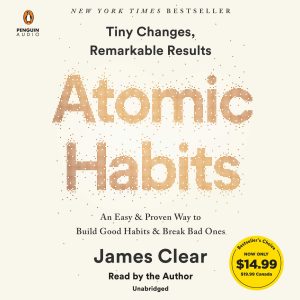Book Review: Atomic Habits by James Clear
 I have been a member of Ros Jones’ Business Bookclub now for almost two years. I have read some really inspiring books and some that were a struggle; until now none of them had made me change what I do before I had even finished reading the book. That is what Atomic Habits has done for me.
I have been a member of Ros Jones’ Business Bookclub now for almost two years. I have read some really inspiring books and some that were a struggle; until now none of them had made me change what I do before I had even finished reading the book. That is what Atomic Habits has done for me.
Business books and self improvement books in general tell you to set goals and targets and then focus on them. This book tells you to forget about goals and focus on systems. It even tells us the problem with goals: they are the same for the winners and the losers; achieving a goal in only a momentary change; goals restrict your happiness; goals are odds with long term progress. All this rings so true with me and my life.
James Clear talks about how habits shape your identity and vice versa – he explains how the more pride you have in your identity the more motivated you will be to maintain habits associated with this identity. This one is relevant to me: “the goal is not to run a marathon, the goal is to become a runner.” I ran a marathon way before I identified as a runner. Now I run at least three times a week but am not the slightest bit interested in running a marathon. Running is now part of who I am.
Building Good Habits
After talking about a systems approach to starting good habits and breaking bad ones, James Clear then goes into practical steps of how to do this. The reference to atoms is making small changes that all build up over time:
“Habits are like the atoms of our lives. Each one is a fundamental unit that contributes to your overall improvement.”
He looks at the four phases of developing a habit and offers several ideas for starting good habits. I have found two of these approached particularly useful so far, firstly habit stacking and the other implementation intention. Here’s how I have put these into practice:
I am really bad at housework, I always say I haven’t got time and then do a massive clear up once in a while, however by tidying this way I only have a momentary change. It looks good for a short while but soon the mess builds up again. So the first thing I have started doing is habit stacking – building on a habit I already have – so after I brush my teeth in the morning I will clean the sink and surrounding area; after I have had my bath I will clean the bath area. I know that for many people this is what they already do as a habit, for me I am just starting out. The second thing I have done (and written down) is when Peter is making the tea I will vacuum. And again this is working. By doing these things regularly I am building a habit, I like to see things clean and it takes up very little time every day. Once these are second nature I will add more. By improving in small steps, the improvements will build up over time.
Breaking Bad Habits
My main bad habit is procrastination – at work and at home. In the office I frequently think I’ll have a 5 minute cuppa and play solitaire whilst I have a break. But that 5 minutes can expand to 20 very easily and time equals money. So, using one of the tips for breaking a bad habit: make it hard – I have removed the online solitaire from my laptop. So now I can’t just click a button and play. Result, I spend that 5 to 10 minutes with a cuppa clearing my inbox and organising my work. And, I am expecting that when I start monitoring my Toggl reports at the end of the month my chargeable hours will go up.
The next bad habit to break is watching TV for the sake of it. I am looking at ways of using technology (as recommended in the book) break that habit and to start a good habit of writing a nature blog. Watch this space!
Across the whole book James Clear explains the four laws of behaviour change. To make good habits
- make it obvious
- make it attractive
- make it easy
- make it satisfying
And to break bad habits
- make it invisible
- make it unattractive
- make it hard
- make it unsatisfying.
If you want to learn techniques to build good habits and break bad habits, I would highly recommend you read this book. For me, well I am still looking at ways to improve, a bit at a time and next year perhaps I’ll be reporting further on the “Tiny changes. Remarkable results.”
You can read about Ros Jones’ Business BookClub and find out how to join here
